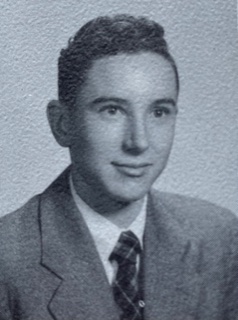The History of Stamford High’s “Hateman”

January 4, 2022
The year is 1975 in Berkeley, California. A homeless man is pushing you to decide whether or not you get the last cigarette he is selling, to teach you proper conflict management. He suggests you push back with all the force of your want to show if you really deserve it, before retreating back to his tent on the east of Telegraph Avenue. A person could be forgiven for thinking he learned his way of life from growing up on these very streets, but in actuality, he grew up in Stamford, Connecticut.
This past September, the Stamford High Round Table was sent a cryptic package with images of an unusual man said to have graduated in 1954. There was a note included by his sister, Prudence Hawthorne, which said “Hope you all enjoy the former ‘Mark Hawthorne’s” lifestyle and lifetime effects – From his sister.” This led us to our archives and the 1954 yearbook, and with a few phone calls to Mark’s sister, I was able to enlighten myself about a philosopher who once walked my very same hallways. After sifting through multiple news sources, conversations with his sister, and our resources at Stamford High with utter confusion, I am finally ready to explain the unconventional, courageous, and mysterious story of Hateman.
Mark Hawthorne was born September 26, 1936 in Stamford’s Belltown neighborhood. He went to Dolan for 9th grade, and Stamford High School for 10th, 11th and 12th. His sister said he was often described as interesting and eccentric by his high school teachers. He graduated in 1954 with the caption under his photo reading: Mark, the man who tickled our funny bone . . . witty addition to Political Science and International Relations Clubs . . . shoots a mighty mean rifle . . . flashed at swimming, sailing, golfing . . . will perpetuate his humor at a college campus.
Mark was the managing editor of the Round Table. By his sister’s recollection, he was a born writer. Thanks to father’s profession in journalism, he was constantly surrounded by it. His father’s advice to Mark was that to be a good writer, you must write every day, because practice improves your skills. From then on, Mark wrote every day throughout his adult years, starting seriously writing during his time here at Stamford High.
He took up calligraphy and swore by sharpening his writing pencils with an Exacto knife, which was the first sign that he could do what he loved without having to do it the traditional way (like using a pencil sharpener).

He was a part of the ROTC in high school, which helped him pay for his college education at the University of Connecticut. He later became an Intelligence officer in the Air force. From there he joined the Peace Corps for two years and became an established writer for the New York Times.
After the Peace Corps, he and his young wife and child moved into a New York City apartment, and he started as a writer for the New York Times. A few years later, he divorced his wife and left his job at the New York Times, around the time that he was injured by a drunk driver that shattered his hip. After the injury, he was divorced and moved to Greenwich village. He lived in an apartment here. He left the Times. After a year in Greenwich Village, people encouraged him to make the move out west to get in touch with more freethinkers. His main goal was “conflict management” which was getting people to be more responsive and respectful to one and other. He did a lot of filming in Central Park to showcase the beauties of unconventional, natural life, before moving out to California in 1973. His wife and daughter never understood him: he showed “love” through the word “hate” and would tell his daughter you have to say “I hate you” to him or he would not talk to her.
This is how he donned the alias “Hateman.” Hateman’s philosophy and life purpose was conflict management. He wished that he could help rid people of their anger towards each other. This was seemingly contradictory to his name, but he chose the word “hate” because it was abundant and eye-catching and what many people choose, but deep down his message was for everyone to care about each other. If someone came up to him who was rough and mean, – an analogy for Hateman’s view on the cumulative attitude of the world – the evils that lurk within us all, he would react with methods he curated so neither side was hurt and a compromise could be made rather than in anger or resentment or fear. Hateman wished people had respect for each other. He believed everyone should be given the same amount of respect, which should be a universal principle, but as Hateman’s philosophical life showed, it isn’t.

Hateman had a specific method to deal with conflict: “The Pushing.” You stand shoulder-to-shoulder with another person who may want something from you (money, where you are sitting in a classroom, your parking space in a grocery store parking lot, etc.) and they are being very rude about it. Instead of having this carry on, Hateman would persuade them to “push” for it. As the shoulders push, the power dynamic between the two is physically revealed. It could go on for hours. Usually, 5-10 minutes would be the average for a “push.” If one of the people in the argument knows one needs something more, the person in need will push longer and more firmly, and the other person absorbs that realization that the other person has more desperation than them. This takes away the selfishness from the argument and transforms it into an intimate moment between two strangers: where one respects the other enough to grant them something they could have taken for themselves. A record push lasted for 10 hours at Berkeley, CA at People’s Park. “The Pushings” started around 1973 when he moved to California.
He continued this method to resolve conflict until he died. He would be sitting on his sleeping back in a particular corner of People’s Park which was known as “Hate Camp.” It was a 2-3 block area in People’s Park where he resided for 37 years. People knew that they were safer if they parked their sleeping bag and belongings near Hateman because he created an atmosphere of mutual respect. Everyone at Hate Camp had a “street name.” He chose to live in Hate Camp rather than an apartment because if he lived indoors, no one would be passing by to impact, to change their attitude towards humanity. Hate Camp welcomed displaced homeowners after an earthquake in California as well as fires in Oakland. He taught people who lost their homes how to live off the street and deal with people in a prosperous way. If you could find your way to People’s Park, you were in good hands. He was a key figure at Berkeley. A large group still follows his philosophy, thinking of him as an unconventional social worker.
Despite residing in Hate Camp for most of his life, he was donated a shed for times when the animosity towards the homeless grew too strong. A friend of his who was so deeply affected by his teachings lent it to him. This shed is also where he kept his writings safe, as he never stopped writing throughout his life. It was only a couple of blocks from People’s Park.
The irony of the alias “Hateman” was that he was all about caring. Living outside, many people can act viciously because the environment is so volatile. His sister Prudence talked of how one time a man pushed Hateman into her and Hateman responded, “Are you okay?” to which she responded, “yeah.” Hateman had tears in his eyes and said, “I do not care when people shove me or are mean to me, but what bothers me is that at that point, that person does not care for you or me.” The essence of turning this want for people to care for one and other into the concept, or rather the title “hate”, was because he believed that “gushy love” was phony and boring. He despised “phoniness.” That was his biggest swear word, phony, (his biggest literary influence was the Catcher and the Rye). To be phony was to not care about truth, not care about honesty. The “hate” word got people to pay attention. After all, our world is gravitated to the evils and darkness’s of the world. That is why people have fixations with crime shows among other things. His contradiction with this play on words was just as Iceland and Greenland chose their names, people in this world hate more than they love. They hate on people they do not know by not showing them respect. Hateman knew this, so he created the ironic title of “hate” to teach about respect. He would spell any word he did not like. For example, he was fearful of getting cancer, so he would spell it out when referring to it. He did the same for love. He was superstitious, but held no religious affiliation.

The overall message is that you never really know what someone is like on the inside based on their appearance. You must broaden your possibilities of trust. Understand that despite unconventionality, people are still humans. We live in a society where unpopular opinions create outcasts and complete societal shunning, and with Hateman, he chose to channel this world of hate into a positive thing. Instead of profiling people for their ideas and circumstances, try to understand what they bring forth. Hateman lived out his philosophy: he had a fascinating history, yet people profiled him to just be a “loony, homeless guy.” Without such societal judgment, the world would be a better place in Hateman’s eyes.
His legacy was that of a man with such a generous philosophy who was misunderstood due to his unconventional, eccentric approach. People saw a man who lived on the street, but what people did not know was that he once was a big time writer at the New York Times; he chose this way of life because he thought it was the only way to live authentically. He had a partner, Jade, and daughter, Zizi Hawthorne, at Berkeley who were very faithful to his philosophy. According to his sister, the family of Hateman have witnessed police officers “pushing” to resolve conflict. His supporters and family are very proud that after almost five years after his passing, his methods of resolution are still practiced. Hateman wanted to find a lifestyle that did not consist of an 8 hour work day at an office, where you don’t even know what you’re doing is useful.
His sister Prudence is struggling to keep his legacy alive and has a GoFundMe to collect money to preserve his memory (https://www.gofundme.com/f/wpp5wh-preserve-the-memory-of-berkeleys-hateman?utm_medium=email&utm_source=product&utm_campaign=p_email%2B7002-thank-you-instructions-v5&fbclid=IwAR1oUxi2yrf65SbG4pcFIlvoQ-Z3fZLyPNBFvVsTYNlsw5N-NXPITxVBN74). She wants to get his archived writings into UC Berkeley, his films from New York (which his sister requests be free for all to watch), and hopefully a statue of him on “Telegraph Avenue.” This will be in hope of keeping his teachings alive among future generations.



